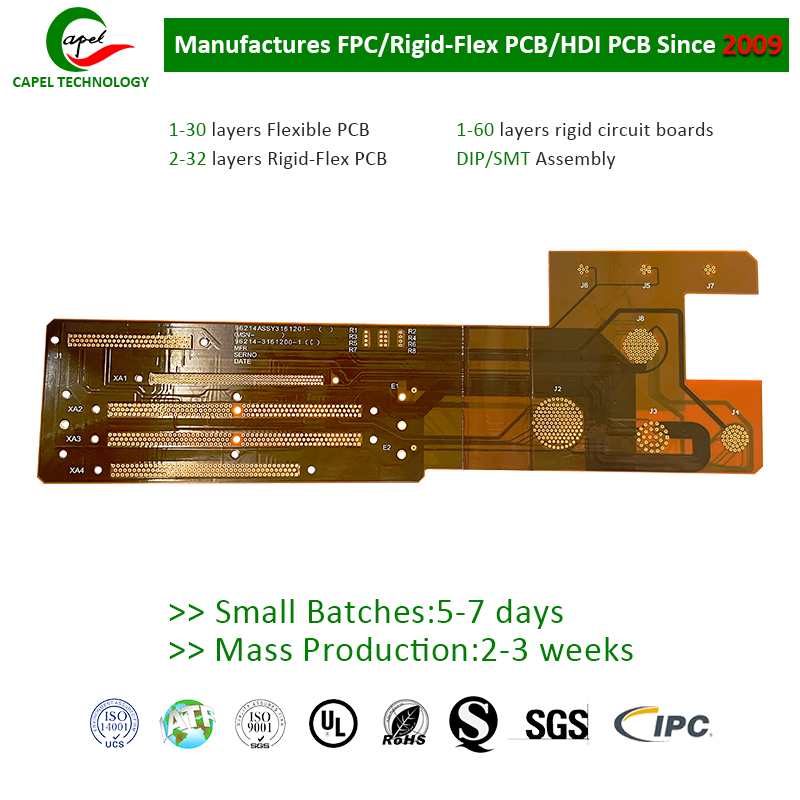Capel: Your trusted multi-layer flexible PCB manufacturing partner
Since 2009, Capel has been at the forefront of the electronics manufacturing industry, focusing on the manufacturing and production of mid-to-high-end flexible circuit boards, rigid-flex circuit boards, and HDI PCBs, and has become a trustworthy electronics manufacturer. It is a trustworthy partner for many companies in various industries. With 15 years of rich industry and technical experience, a strong team of experts, and advanced fully automated production equipment, Capel is committed to providing customers with reliable and rapid prototype production to successfully launch their projects.
For multi-layer flexible PCBs, impedance control technology and testing methods play a vital role in ensuring the precision and accuracy of the manufacturing process. In this blog post, we’ll explore how to choose the right impedance control technology and test method for your multilayer flexible PCB, and why Capel is the ideal choice for your manufacturing needs.
Learn about impedance control technology
Impedance control technology refers to the management of PCB internal electrical impedance. It ensures that the signals transmitted through the PCB circuit are not affected by external interference, thus ensuring the overall performance and reliability of the device. For multi-layer flexible PCBs, impedance control becomes more important due to the complexity of the circuit.
The first step in choosing the right impedance control technology is to understand the specific requirements of a multilayer flexible PCB design. Factors such as signal frequency, board thickness, dielectric constant, copper thickness, and substrate material all affect the impedance value. By accurately determining these parameters, you can select the appropriate impedance control technology for your PCB.
Types of Impedance Control Technology
1. Design techniques: One method of impedance control is to design the PCB layout to achieve the desired impedance. This involves adjusting trace widths, spacing, and impedance calculations to meet the required specifications. Capel employs experienced designers who are proficient in impedance control techniques to ensure that your multi-layer flexible PCB layout meets your impedance requirements.
2. Controlling the dielectric constant: Choosing a material with a known and stable dielectric constant is another way to achieve impedance control. By selecting a substrate with precise dielectric properties, you can maintain consistent impedance values throughout a multilayer flexible PCB. Capel uses high-quality materials with reliable dielectric constants to ensure accurate impedance control.
3. Embedded components: Embedding passive components, such as resistors and capacitors, inside the PCB can help achieve impedance control. This technology requires no external components, reducing the overall size and weight of the PCB while maintaining precise impedance values. Capel’s ability to accurately embed these components further improves the performance and reliability of multi-layer flexible PCBs.
Choose the right testing method
Once the appropriate impedance control technology is selected, thorough testing is critical to ensure that multi-layer flexible PCBs meet the required specifications. Capel uses advanced testing methods to ensure PCB accuracy and functionality.
1. Time Domain Reflectometry (TDR): TDR is a common technique for measuring impedance discontinuities. By sending a pulse through a transmission line and analyzing the reflected waveform, impedance mismatches and other signal integrity issues can be identified. Capel uses TDR testing to accurately measure the impedance of multi-layer flexible PCBs.
2. Vector Network Analyzer (VNA): A VNA is a multi-functional instrument used to measure the electrical characteristics of high-frequency equipment, including impedance. It provides accurate measurements over a wide frequency range, making it suitable for testing multi-layer flexible PCBs with various impedance requirements. Capel uses VNA testing to ensure the integrity of PCB designs.
3. Test patch: Using a test patch is a representative part of the actual PCB and is an effective method to verify the impedance value. By fabricating a specific portion of the PCB with a known impedance value, manufacturers can compare the measured impedance to the expected value. Capel uses test coupons to verify the accuracy of impedance control in multilayer flexible PCBs.
Why choose Capel for your multi-layer flexible PCB needs?
With extensive experience in manufacturing high-quality flexible circuit boards and a commitment to utilizing advanced technology, Capel is the ideal choice for your multi-layer flexible PCB requirements. Choose Capel, you will benefit from:
1. Rich industry and technical experience:
Capel’s 15 years of industry experience is a testament to its commitment to quality and innovation. Capel has a strong team of experts who understand the unique challenges associated with multi-layer flexible PCB manufacturing and can provide valuable insights and solutions.
2. Advanced fully automatic production equipment:
Capel’s investment in advanced automated production equipment ensures precision and efficiency throughout the manufacturing process. By leveraging the latest technology, Capel provides reliable, rapid prototyping so you can complete your project on time.
3. Commitment to customer success:
At Capel, customer satisfaction is of the utmost importance. By providing reliable prototype production, technical expertise and exceptional customer service, Capel is committed to helping customers successfully launch their projects. Capel’s focus on customer success sets it apart from other PCB manufacturers.
In summary, selecting the correct impedance control technology and testing methods for multilayer flexible PCBs is critical to obtaining accurate and reliable results. By partnering with Capel, you can leverage its extensive industry experience, advanced production equipment and commitment to customer success to ensure your multi-layer flexible PCB meets the highest quality and performance standards.
Post time: Sep-30-2023
Back







